South Carolina is known well for residents’ southern drawl, their friendliness, the sweet tea, and the blisteringly hot summer days. However, if you’re new to the South Carolina scene, or even if you’ve been here all your life, there are a few snakes that you’ll need to watch out for, especially during the summer season.
In this guide, we’ll tell you about the poisonous snake species you should watch out for and several water snake species that aren’t poisonous. However, they will still scare you, which you’ll want to keep an eye out for whether you’re visiting the hiking trails, fishing in the swamps and rivers, or having a picnic on your back porch on a breezy spring evening.

The 11 Snake Species Found in South Carolina
1. Midland Water Snake
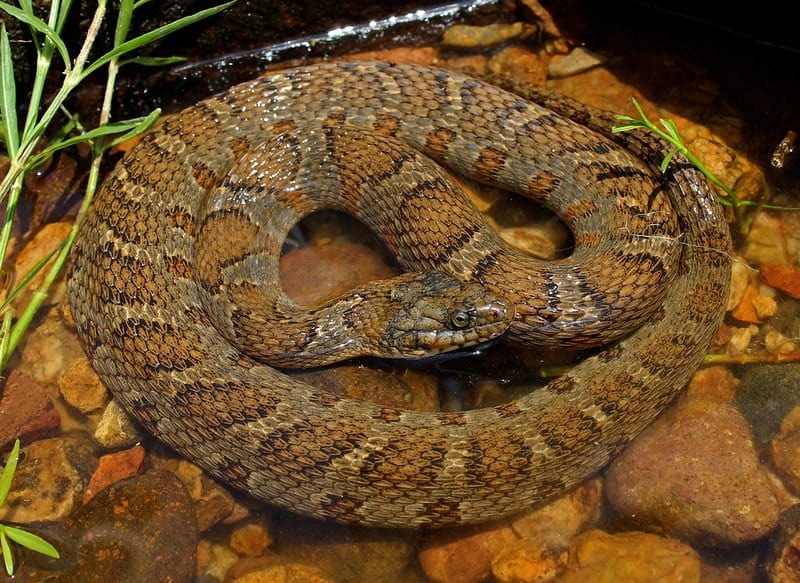
| Species: | Nerodia sipedon pleuralis |
| Longevity: | 9 years |
| Good to own as a pet?: | Yes |
| Legal to own?: | Yes |
| Adult size: | 22 to 40 inches |
| Diet: | Carnivorous |
The midland water snake hails from the northwestern area of South Carolina and tops out at 22 to 40 inches long when it reaches adulthood. These and most other water snakes are said to make great pets.
The bad thing about this species is that their coloring is a lot like the cottonmouth and copperhead, two snakes that are poisonous. This means people kill them when they see them when there’s no need to.
The species are carnivores, which means they like to snack on fish, frogs, and even other snakes at times. These snakes are not venomous but will often mimic the actions of a venomous snake to scare away prey. They kill their prey by constriction.
The natural predators for this species include bass and other sports fish, raccoons, foxes, snapping turtles, and even hawks.
2. Northern Water Snake

| Species: | Nerodia sipedon |
| Longevity: | 9 years |
| Good to own as a pet?: | Yes |
| Legal to own?: | Yes |
| Adult size: | 22 to 53 inches |
| Diet: | Carnivorous |
The northern water snake is found in the extreme northwestern parts of South Carolina, close to the border. These snakes grow to between 22 and 53 inches by the time they reach adulthood, making them one scary sight if you’re out walking and run across one.
They prefer to live near the water and can often be found hiding in beaver dams or muskrat houses. While this species can be active all the time, you’ll see them out hunting most often at night. They live off frogs, worms, and the smaller fish in the water source they occupy.
The natural predators of this species include raccoons, opossums, birds of prey, coyotes, and snapping turtles.
3. Brown Water Snake
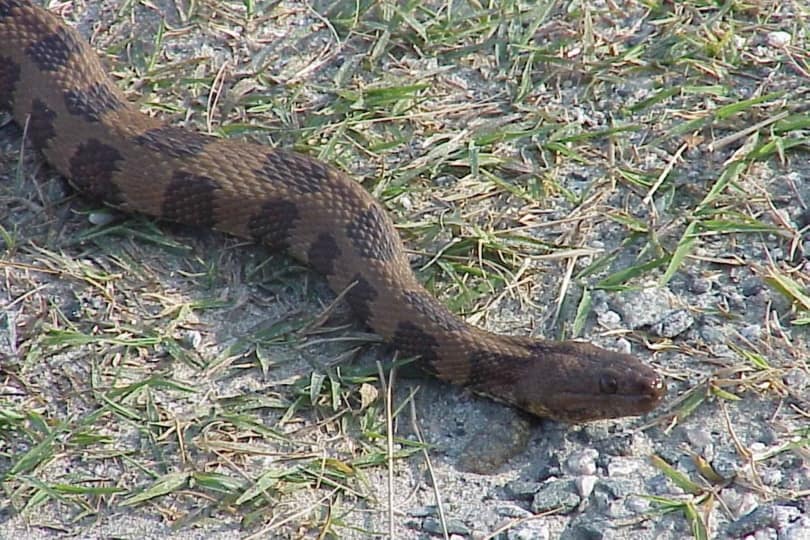
| Species: | Nerodia taxispilota |
| Longevity: | 6 years |
| Good to own as a pet?: | Yes |
| Legal to own?: | Yes |
| Adult size: | 30 to 60 inches |
| Diet: | Carnivorous |
Brown water snakes are some of the largest snakes in South Carolina, growing to between 30 and 60 inches as they mature into adulthood. Their favorite prey is catfish, so they love to live in the larger rivers of South Carolina, which give them plenty to hunt. Unfortunately, this species also gets mistaken for a cottonmouth, though they are not venomous at all.
You can often find the brown water snake basking in the sun spread out along tree branches instead of lying on the ground. Since they tend to be in trees a lot, they sometimes find themselves falling into people’s boats. While they can’t kill you, be careful, they have very sharp teeth and will bite in their own defense. This species doesn’t have many predators due to its large size. The biggest threat to the brown water snake is humans.
4. Green Water Snake

| Species: | Nerodia floridana |
| Longevity: | 8 years |
| Good to own as a pet?: | Yes |
| Legal to own?: | Yes |
| Adult size: | 30 to 55 inches |
| Diet: | Carnivorous |
The green water snake is also non-venomous and grows to between 30 and 55 inches. These snakes are carnivores, so they prey on fish and small amphibians, mostly during the day. While most green water snakes are in Florida, they do live in South Carolina and Georgia as well.
They can usually be found in the wetlands and like to have plenty of vegetation to hide in. Natural predators of this species include hawks and humans. These water snakes are not constrictors. They simply snatch their prey and swallow it quickly instead.
5. Banded Water Snake
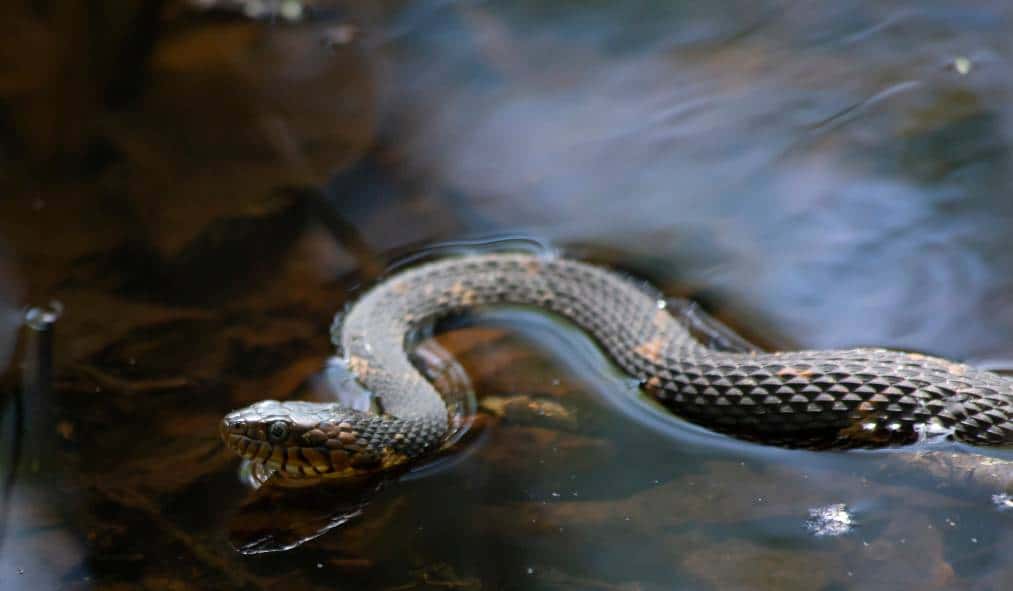
| Species: | Nerodia fasciata |
| Longevity: | 2 years |
| Good to own as a pet?: | Yes |
| Legal to own?: | Yes |
| Adult size: | 24 to 42 inches |
| Diet: | Carnivorous |
The banded water snake lives in the swamps, lakes, and rivers of Eastern South Carolina. It grows to be between 24 to 42 inches and prefers frogs and fish for its food source. Their appearance is similar to a cottonmouth, which is a species they share a home with, so they do get mistaken for cottonmouths often. This species can become aggressive, though they are usually reclusive if left alone. This species has the same natural predators as the other water snakes on our list.
6. Red-Bellied Water Snake
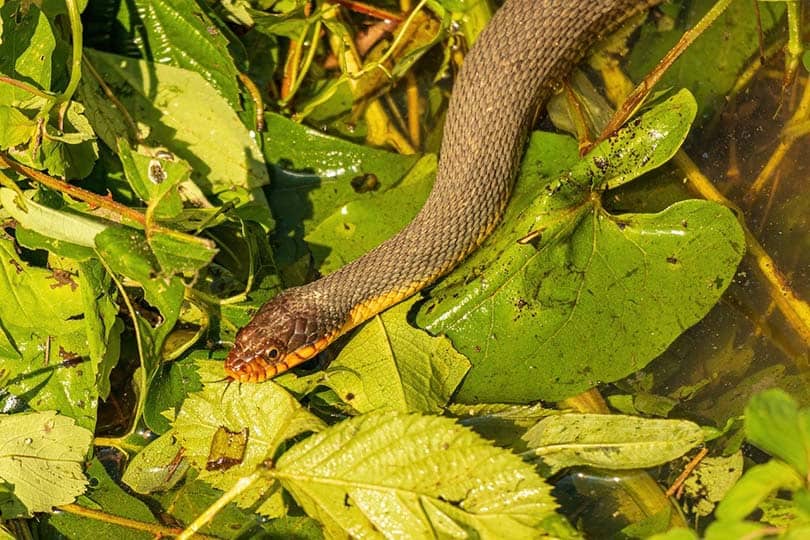
| Species: | Nerodia erythrogaster |
| Longevity: | 4 years |
| Good to own as a pet?: | Yes |
| Legal to own?: | Yes |
| Adult size: | 24 to 40 inches |
| Diet: | Carnivorous |
The red-bellied water snake, named for its red belly, is found mostly in the lakes and swamps of South Carolina, though they have been found in rivers. They reach between 24 and 40 inches in length and are carnivores who feast on small animals and fish on and off the land. They are nocturnal, and unlike the other water snakes on our list, they will travel for long distances by land to find another body of water.
These snakes can be aggressive if threatened and will repeatedly bite while spraying a musk-like substance at their attacker.
7. Cottonmouth (Water Moccasin) (Venomous)
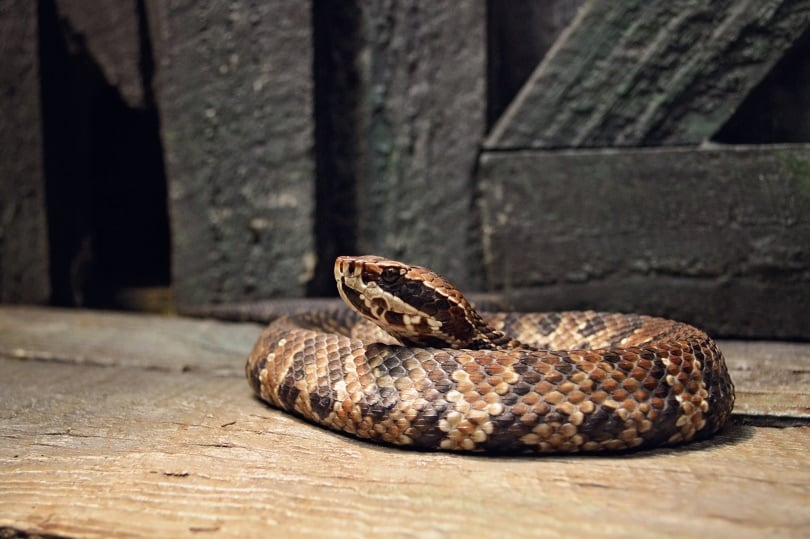
| Species: | Agkistrodon piscivorus |
| Longevity: | 10 years |
| Good to own as a pet?: | No |
| Legal to own?: | No |
| Adult size: | 36 to 38 inches |
| Diet: | Carnivorous |
When most people in South Carolina think of a water snake, the cottonmouth, also called the water moccasin, is what instantly comes to mind. Unfortunately, this snake is venomous, and many of the above snakes are harmed when people think they have run across a cottonmouth.
This species of snake is infamous and can often be seen swimming in the water in South Carolina swamps, rivers, and waterways. Just like regular water snakes, this species feeds on fish, reptiles, and amphibians.
If you’re bitten by a cottonmouth, it’s critical to get treated right away.
8. Copperhead (Venomous)
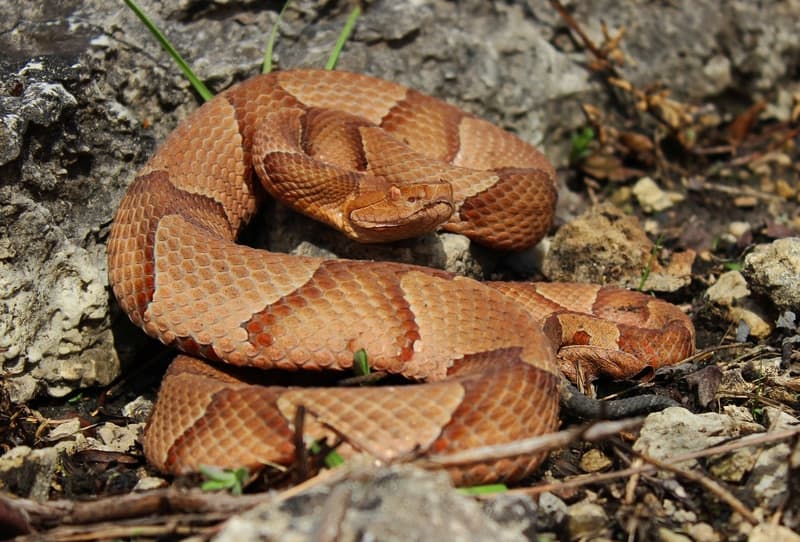
| Species: | Agkistrodon contortrix |
| Longevity: | 25 years |
| Good to own as a pet?: | No |
| Legal to own?: | No |
| Adult size: | 19.7 to 37.4 inches |
| Diet: | Carnivorous |
The copperhead is a venomous snake that reaches up to 37.4 inches in length by adulthood. It has a stout body and a broad head. This species eats small rodents, frogs, and insects.
Though it’s very seldom fatal, the bite of a copperhead is poisonous, so you do need to seek medical treatment if bitten. This is the most common venomous snake in South Carolina. In the south, this snake is mostly nocturnal during the hot summer months but active during the day in the cooler spring and fall season.
9. Coral Snake (Venomous)
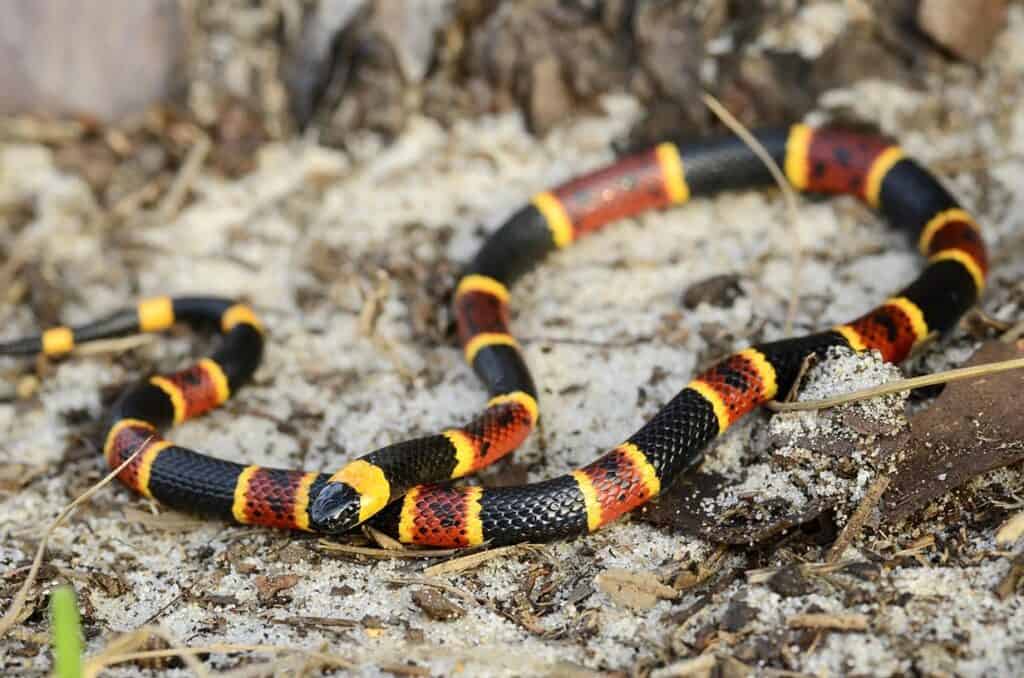
| Species: | Elapidae |
| Longevity: | 7 to 10 years |
| Good to own as a pet?: | No |
| Legal to own?: | No |
| Adult size: | 18 to 20 inches |
| Diet: | Carnivorous |
The coral snake is another venomous species in South Carolina. Though their bite is said to be highly toxic, there hasn’t been a death attributed to this snake since the 1960s. This species dines on frogs, lizards, and small non-scale snakes. They can be found mostly in the marshes of South Carolina. If you’re bitten by a coral snake, you need to seek medical attention right away, as they are said to be the most venomous snake on the planet, next to the black mamba.
10. Eastern Diamondback Rattlesnake (Venomous)
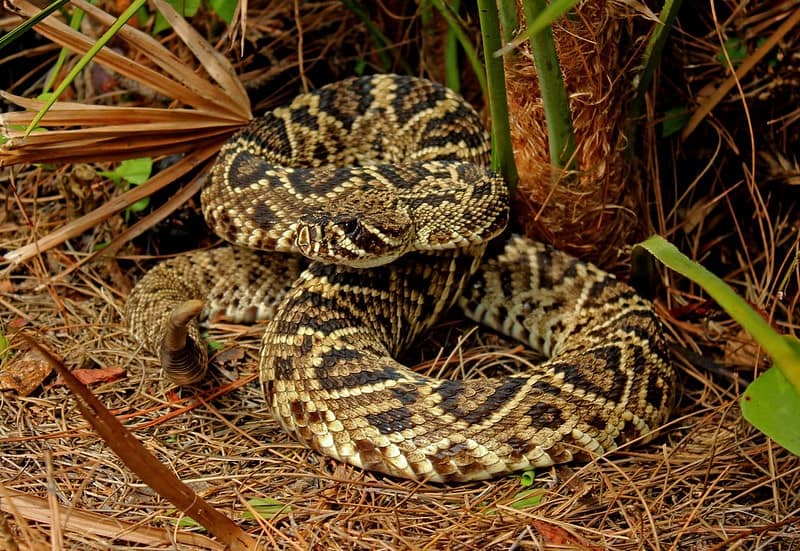
| Species: | Crotalus adamanteus |
| Longevity: | 10 to 15 years |
| Good to own as a pet?: | No |
| Legal to own?: | No |
| Adult size: | 3 to 6 feet long |
| Diet: | Carnivorous |
The eastern diamondback rattlesnake is said to be the largest venomous snake in South Carolina. They reach three to 6 feet long and can weigh up to 10 pounds. The largest ever recorded was 8 feet in length.
These snakes hide and wait for their prey to come into range, then strike to kill them. These rattlesnakes give birth during the summer months, so if you’re hiking trails or walking along the roads of South Carolina in the fall of the year, you need to be careful and watch out for this large predator.
They live in the grasslands, timberlands, and plains of South Carolina.
11. Pygmy Rattlesnake (Venomous)
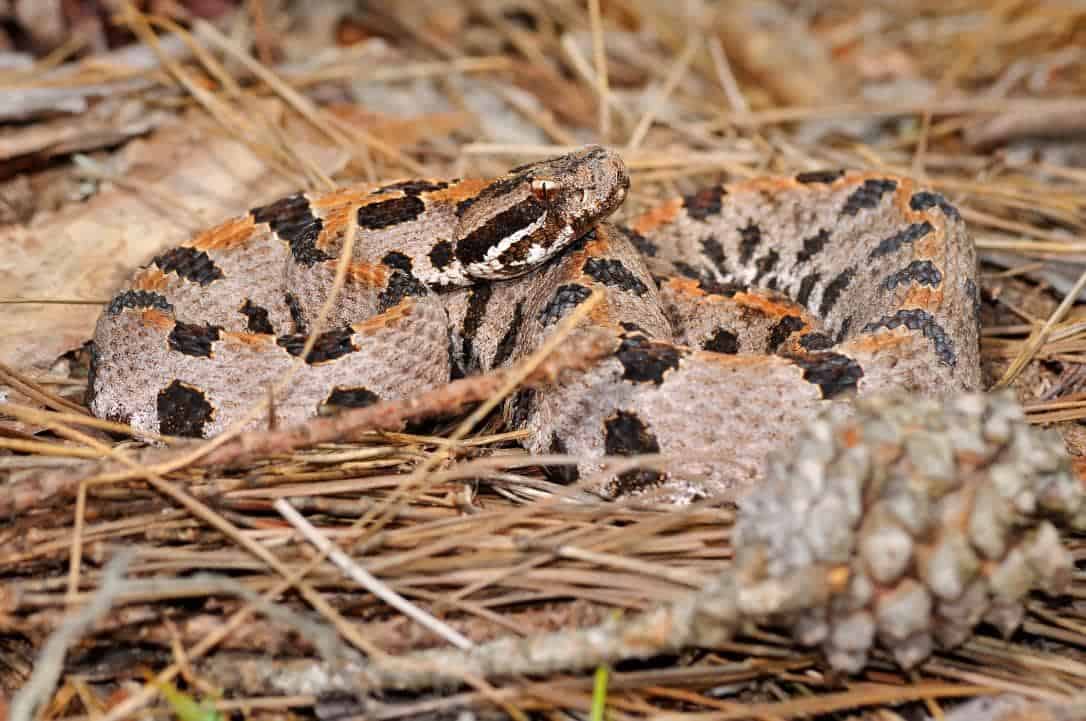
| Species: | Sistrurus miliarius |
| Longevity: | 16 years |
| Good to own as a pet?: | No |
| Legal to own?: | No |
| Adult size: | 14 to 22 inches |
| Diet: | Carnivorous |
The pygmy rattlesnake is the smallest venomous snake in South Carolina, reaching 14 to 22 inches in length by adulthood. This snake is found throughout South Carolina, except in the mountains.
This species eats frogs, centipedes, and insects. Unfortunately, it is also venomous, so if you’re bitten, you need to go to the emergency room for treatment.

Conclusion
This concludes our guide on the 11 snake species in South Carolina. If you’re new to South Carolina, you need to learn them well. Whether you’re on the water, in the swamps, or just reclining in your rocking chair on your front porch, snakes are out and about in South Carolina—especially in the hot, humid summer season.
- You may also be interested to read: 8 Snake Species Found in Georgia (With Pictures)
Featured Image Credit: Patrick K. Campbell, Shutterstock
